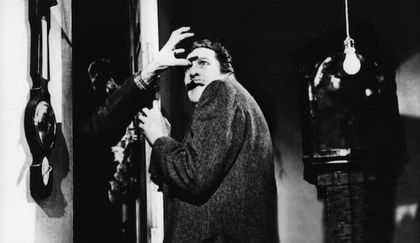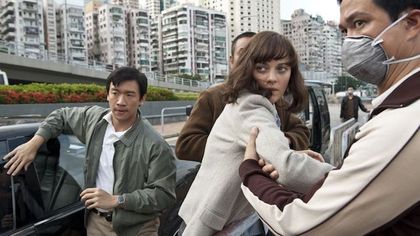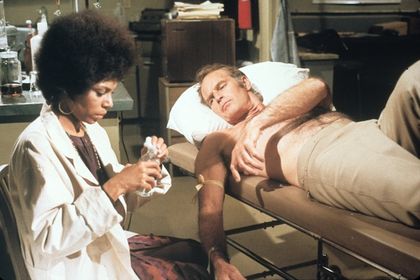The cinema shows many examples of viruses that affect humans, producing devastating epidemics that remind us of our fragility and vulnerability.
 In 2011, the film Contagion gives a lucid vision of this proud global world in all its fragility.
In 2011, the film Contagion gives a lucid vision of this proud global world in all its fragility.
“Nothing spreads like fear”. This was the tagline of “Contagion”" (2011), a film that predicts a pandemic like that of the coronavirus.
Films have long been imagining the panic created by an invisible threat – microscopic in nature – that kills from within. They tell stories that reflect our ancestral fear of weakness and painful death spread through contagion.
Most films on viral epidemics are related to aberrant mutations, such as stories of zombie outbreaks or of terrorism using bio-chemical weapons. Other films relate more easily to what is happening now with COVID-19.
Plagues and epidemics have been with human beings throughout history and have thus provided a great source of inspiration for the silver screen.
Many stories refer to Camus' novel, The Plague (1947), which takes place in the French prefecture on the Algierian coast in the 1940s, while classics like “The Seventh Seal” (1957) delve further back, recounting the spread of the Black Death in sixteenth century Sweden, when the knight played by the now deceased Max von Sydow returns from the Crusades.
The presence of death is so real that it even takes physical form in the chess game shot on the beach at Hovs Sallar – where a plaque from the European Film Academy now commemorates Bergman's film.
In just six years, between 1346 and 1352, it is estimated that twenty million people died in Europe as a result of the Black Death or Bubonic Plague, portrayed on screen in vampire myths such as Murnau's “Nosferatu” (1922) – the count goes into a ship’s hold, full of rats carrying fleas like those that transmit the disease, feeding on blood and causing apparent deaths.
Other films feature pneumonic plagues – airborne and causing death within 48 hours – as in the film noir of “Panic in the Streets” (1950) by Elia Kazan. The science fiction born out of the "cold war" also turns to biological threats, as in Sturges' “The Satan Bug” (1965) and Wise's “The Andromeda Strain” (1971).
 The last man on earth in 1964 is the only survivor of an epidemic that has ravaged humanity.
The last man on earth in 1964 is the only survivor of an epidemic that has ravaged humanity.There are real and fictional diseases in scenarios of biological catastrophe, scientific experimentation and germ warfare, as in Stephen King's book “The Stand “(1978), which was dramatized into a mini-series.
There are acts of terrorism as in “The Cassandra Crossing” (1976), “Unlocked” (2017) and in series like “24” (2001–14). In these, viruses appear to affect human beings by invading their bodies and producing devastating epidemics that remind us of our fragility and vulnerability.
A QUESTION OF SURVIVAL
One of the first pandemic disaster films is “The Last Man on Earth” (1964), based on the novel I am a Legend (1954), by Richard Matheson, who also helped to write the screenplay.
The protagonist is the only survivor of an epidemic that has ravaged humanity and turned the rest of the population into vampires. "Only if you accepted bacteria could you explain the fantastic rapidity of the plague, the geometrical mounting of victims ... Was it possible that the same germ that killed the living provided the energy for the dead?" (New York, Tom Doherty Associates, p. 71).
The film begins with shots of streets strewn with corpses and a voice-over by Vincent Price, someone who has survived three years of a pandemic that is catalogued by newspaper clippings. The germ that has caused the disease is unlike any known bacillus, multiplying rapidly and seemingly indestructible.
The vampire theme is conjured up by the fact that the victims of the infection remain comatosed during the day, are photophobic and allergic to garlic! The corpses are burned in a huge mass grave to prevent them from reviving and spreading the pestilence.
Dr Robert Morgan works at the Institute of Chemical Research to find a vaccine to curb the disease that his wife and daughter are suffering from. Ragona and Salkow's film shows a world that is disintegrating, where communications are cancelled and a state of emergency is declared... Can you imagine this confinement, without the Internet and with soldiers patrolling the streets? That is Matheson's nightmare!
APOCALYPTIC VISIONS
In another adaptation of Matheson's story, “The Omega Man” (1974) by Boris Sagal, a plague that kills 90 per cent of the human population originates in a conflict between Russia and China, reminiscent of the current conspiracy theories about the creation of coronavirus in Wuhan to attack Trump.
The survivors are albino mutants who can't stand sunlight and have formed a medieval millenarianist sect, wearing black habits over purulent faces like sacred stigmas. They hate science and technology, which they consider to be behind what has happened.
Charlton Heston's role as Colonel Neville, saved by an experimental vaccine developed by the army, is later played by Will Smith in “I Am Legend” (2011). This takes place in an uninhabited New York in 2012, where the flora and fauna have reclaimed the Big Apple.
The "darkseekers" show a total lack of humanity, as they devour others. The downside of this film is that Francis Lawrence's version betrays the original story by introducing a happy ending that is far removed from Matheson's story and earlier film adaptations.
This seminal work gives also rise to the zombie films like Romero's “Night of the Living Dead” (1968) – although the connection with disease is already present in Lovecraft's literature – Danny Boyle's “28 Days Later” (2002) and Juan Carlos Fresnadillo's “28 Weeks Later” (2007).
A zombie-producing virus reappears in “Train to Busan” (2016) and in “World War Z” (2013), threatening to destroy humanity.
 In 12 Monkeys, 1995, Terry Gilliam shows a virus that has killed five million people.
In 12 Monkeys, 1995, Terry Gilliam shows a virus that has killed five million people.In Romero's classic the origin is never explained, but it is hinted that radiation may have resulted from the launch of a satellite to Venus, triggering an epidemic that causes mutations.
In the case of Boyle's film, the disease comes from infected chimpanzees that are being held in a laboratory and are released by a group of animal activists. Fresnadillo portrays excrescences, foaming at the mouth and vomiting of blood, as well abuses carried out by the army.
The “Resident Evil” game (2002) also runs upon this theme and a comic book eventually gave rise to the series “The Walking Dead” (2010), which pays little attention to explaining the phenomenon.
We must return to the cinema of real pandemics to find something more recognizable.
FROM OUTBREAK TO CONTAGION
Wolfgang Petersen's film, “Outbreak” (1995) is based on the Ebola virus, a real infectious agent with a biosafety level of four, in other words, presenting a vital risk for humans, as there is no vaccine for it.
The film starring Dustin Hoffman calls the virus Motaba, but it clearly referring to the virus first recorded in 1976 around the Yumbuku hospital, on the banks of the river Ebola, and which was isolated in a centre for disease control and prevention in Atlanta in 1995.
The patients they investigated had been contaminated by chimpanzees that had been decimated by a strange epidemic in Côte d'Ivoire. Today, it is believed that it came from bats.
The action begins in the summer of 1967 in the Motaba River Valley in Zaire, where a strange disease has spread among mercenary soldiers. The US army wants to stop its spread by blowing up their settlement.
The story unfolds when, in 1994, an American army medical team is sent to the area to investigate the virus that continues to kill people. It has been imported into the US by a capuchin monkey that spreads the air-borne disease in a town in California.
The army general played by Donald Sutherland conceals the obscure origins of the virus, which had been used as a biological weapon.
“Fatal Contact” (2006), directed by Richard Pearce, turns to a bird flu that begins in China, but then spreads to the United States, where it is estimated that some forty to sixty per cent of those infected will die.
Thousands are dying around the globe, pushing the economy onto the verge of collapse. The doctor played Joely Richardson travels to Angola with a colleague and discovers that the entire population has died. In “Pandemic” (2007), a miniseries by Armand Mastroianni, a plague originating on the northern coast of Australia spreads to Japan and Europe, reaching Los Angeles through a surfer. Thus the virus travels from one continent to another in a single day.
“NOTHING SPREADS LIKE FEAR”
Soderbergh's film “Contagion” (2011) borrows from both the documentary and the science fiction genre, moving with ambiguity in an undefined terrain. Its informative approach is nevertheless realistic rather than fantastic.
While its pace is relentless, its characters lack dramatic weight. It tells of mass contagion, preventive measures and the urgent search for an antidote.
The film has a star-studded cast, including Gwyneth Paltrow, whose character dies at the start of the film; Matt Damon, whose puts in a good performance; and Jude Law, whose role borders on the caricatural.
His character runs a website that is presented as the source of truth, but what he really does is spread rumours of conspiracies about the pharmaceutical industry’s role in the spread and control of the disease.
The interesting thing about his messianic discourse is that he takes economic advantage of the fear generated by his comments.
 It does not matter the color of the skin, our language, accent or culture, even our ideology, since the virus does not care about our discourse.
It does not matter the color of the skin, our language, accent or culture, even our ideology, since the virus does not care about our discourse.Like other Soderbergh films, it is over time that we begin to appreciate the value of films like “Contagion”. His denunciation of the fallacy of globalization that brings chaos to a hyperconnected and unfiltered society is evident in crises such as the present Coronavirus crisis.
The fear here is not only of a global infection, but also of misinformation due to hyperinformation causing widespread “noise”. At a time like this, we see how well the film documents not only the forms of infection (with close-ups of hands, bodies touching and people breathing infected air), but also the multiple reactions of such diverse and complex characters. All of this is done without resorting to the commercial effects used by disaster films.
The director strips science fiction of its stereotypes to achieve the anxiety caused by the credible. He shows the disturbing reality of a crisis like the one we are now experiencing.
He presents an everyday reality in which spaces, situations and characters become recognizable. Its casual genesis, frighteningly anecdotal, shows the inevitability of the present situation. It gives us a lucid vision of this arrogant globalized world in all its fragility.
APOCALYPSE NOW?
The list of post-apocalyptic scenarios that these stories open up are endless. In Terry Gilliam's “12 Monkeys” (1995), a virus is released and kills five million people, driving survivors underground. Scientists send a criminal, played Bruce Willis, to gather information about the terrorists attack thought to be behind it, in order to discover a cure.
They use experiments like those in “V for Vendetta” (2006), first carried out on homosexuals, to show the great conspiracy between the army, science and the church. In this sense, the ghosts do not change much.
In Elio Quiroga’s “The Dark Hour” (2006), a war of religion pits humanity against itself, and the survivors even take biblical names. The ending is hopeless.
In “Doomsday” (2008), directed by Neil Marshall, Scotland is under quarantine, isolated from England by a containment wall. The fictional virus nevertheless spreads and science has no cure.
In Shyamalan's “The Happening” (2008), poisonous toxins come from plants due to a possible terrorist attack, but human beings end up being the planet’s real allergy. What causes the virus is a series of mass suicides. In the adaptation of Saramago's book, Blindness (2008), an epidemic leads to blindness.
Those affected are placed in quarantine. After fleeing confinement due to overcrowding, they discover that they are living in a country of blind people. "Without a future, the present serves no purpose, it’s as if it did not exist" (translation from Portuguese: New York, Harcourt Brace, 1997, p. 229).
Evil cannot be defeated. As in Camus' The Plague, Dr Rieux "knew what those jubilant crowds did not know but could have learned from books: that the plague bacillus never dies or disappears for good” (translation from French: Middlesex, Penguin Books, 1960, pp. 252).
What these films show us is that human beings are an endangered species. Whether it is through the action of infectious and pathogenic agents, or that of biological weapons, we will disappear from the face of the earth.
This clashes with the optimism with which a crisis like the coronavirus is faced. In an interview with The New Yorker, Yale medical history professor Frank Snowden was asked if our future has already been decided for us.
He said that, in fathoming that question, one must take into account the biblical truth that “there’s also a dark side to humanity and that is part of the interest of this”.
 In The Last Man Alive, 1974, the origin of the plague that kills 90% of the human population is in a conflict between Russia and China.
In The Last Man Alive, 1974, the origin of the plague that kills 90% of the human population is in a conflict between Russia and China.
IS THERE HOPE?
What does a moment of crisis like this teach us? The first and most obvious thing is that it reveals our fragility. Attempts are being made to contain the spread of this virus, but we are already hearing about viruses that are even more aggressive and contagious than this one.
In the face of such a threat, should we not assume that our species will become extinct? History and experience teach us that, if it were up to us, we would be incapable of preventing it.
We are weak and vulnerable. As the old book says: “[a]s for man, his days are like grass; as a flower of the field, so he flourishes. For the wind [or coronavirus] passes over it, and it is gone, and its place remembers it no more” (Psalm 103:15–16).
Second, global pandemics like this one show us the fundamental equality of human beings, beyond any national or ethnic barrier. The virus is not Chinese, but of the whole human family, in the same way as we have one same Creator (Genesis 1:17).
The colour of our skin, the language we speak, our accent or culture, or even our ideology do not matter. The virus is indiscriminate. The suffering and pain of loss make us equal in our weakness and ignorance.
Third, situations like this show us our lack of control. We think we are masters of our own destiny but the reality is that we have no control over our own lives. The sense of power we have is pure illusion.
The reality revealed by the bursting of the coronavirus bubble is that we have no control. At times like this it's easy to be dominated by fear. Indeed, “nothing spreads like fear”.
 The Author of Life itself dwelt among those infected with a greater virus. He did not wear chemical protective clothing, but breathed the same air as usand died on his own,
The Author of Life itself dwelt among those infected with a greater virus. He did not wear chemical protective clothing, but breathed the same air as usand died on his own,
WHO IS IN CONTROL?
The coronavirus is everywhere, on our screens, on the keyboards we touch, in the air we breathe... Is anyone in control of all this? We can't put our trust in a distant star or in an unknown deity.
We can only have faith in the God who has revealed Himself in Jesus Christ as the Good Shepherd, the resurrection and the life (John 11:25). Only He can guide us through the storm. In Him we can trust in a future where there will no longer be tears, pain and death (Revelation 21:4).
The story of the Bible is that of a God who has entered a world affected by a virus greater than the coronavirus, much more lethal and contagious, which strikes every human being. It leads us not only to certain death but also to eternal death.
The Author of Life Himself dwelt among those infected by that disease. He did not wear chemical protective clothing, but breathed the same air as us. He died on his own, excluded by his people.
Yet, far from his Father, on that cross, he produced the antidote to this disease. “He who believes in Me, though he may die, he shall live. And whoever lives and believes in Me shall never die. Do you believe this?” (John. 11:25-26).

Las opiniones vertidas por nuestros colaboradores se realizan a nivel personal, pudiendo coincidir o no con la postura de la dirección de Protestante Digital.
Si quieres comentar o